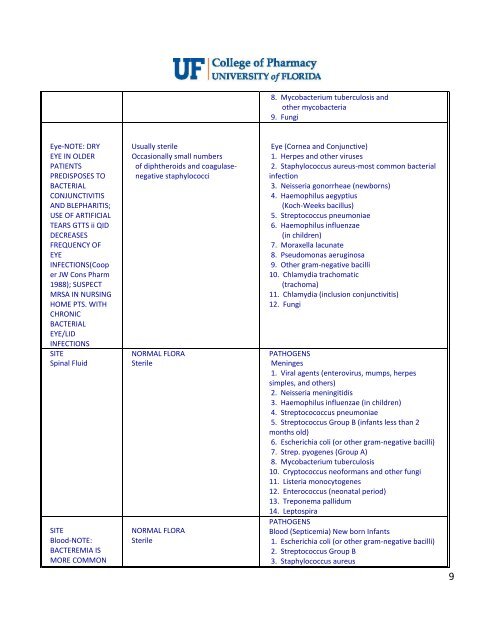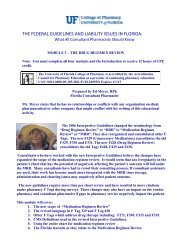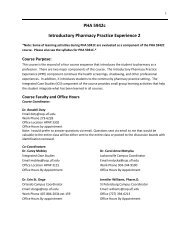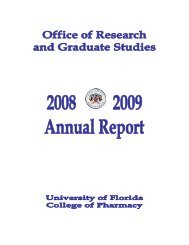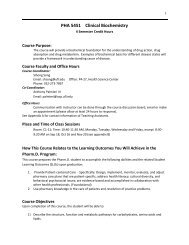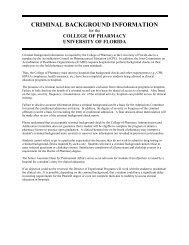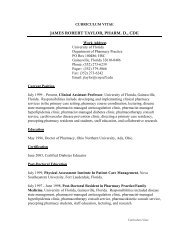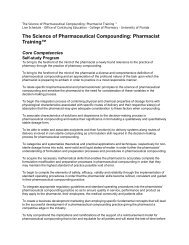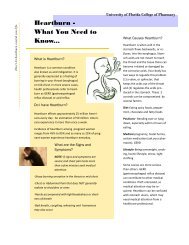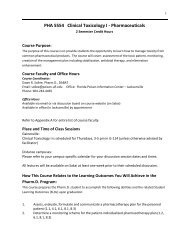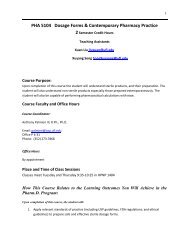INFECTIOUS DISEASE REVIEW Upper Respiratory Tract Infections
INFECTIOUS DISEASE REVIEW Upper Respiratory Tract Infections
INFECTIOUS DISEASE REVIEW Upper Respiratory Tract Infections
Create successful ePaper yourself
Turn your PDF publications into a flip-book with our unique Google optimized e-Paper software.
Eye-NOTE: DRY<br />
EYE IN OLDER<br />
PATIENTS<br />
PREDISPOSES TO<br />
BACTERIAL<br />
CONJUNCTIVITIS<br />
AND BLEPHARITIS;<br />
USE OF ARTIFICIAL<br />
TEARS GTTS ii QID<br />
DECREASES<br />
FREQUENCY OF<br />
EYE<br />
INFECTIONS(Coop<br />
er JW Cons Pharm<br />
1988); SUSPECT<br />
MRSA IN NURSING<br />
HOME PTS. WITH<br />
CHRONIC<br />
BACTERIAL<br />
EYE/LID<br />
INFECTIONS<br />
SITE<br />
Spinal Fluid<br />
SITE<br />
Blood-NOTE:<br />
BACTEREMIA IS<br />
MORE COMMON<br />
Usually sterile<br />
Occasionally small numbers<br />
of diphtheroids and coagulase-<br />
negative staphylococci<br />
NORMAL FLORA<br />
Sterile<br />
NORMAL FLORA<br />
Sterile<br />
8. Mycobacterium tuberculosis and<br />
other mycobacteria<br />
9. Fungi<br />
Eye (Cornea and Conjunctive)<br />
1. Herpes and other viruses<br />
2. Staphylococcus aureus-most common bacterial<br />
infection<br />
3. Neisseria gonorrheae (newborns)<br />
4. Haemophilus aegyptius<br />
(Koch-Weeks bacillus)<br />
5. Streptococcus pneumoniae<br />
6. Haemophilus influenzae<br />
(in children)<br />
7. Moraxella lacunate<br />
8. Pseudomonas aeruginosa<br />
9. Other gram-negative bacilli<br />
10. Chlamydia trachomatic<br />
(trachoma)<br />
11. Chlamydia (inclusion conjunctivitis)<br />
12. Fungi<br />
PATHOGENS<br />
Meninges<br />
1. Viral agents (enterovirus, mumps, herpes<br />
simples, and others)<br />
2. Neisseria meningitidis<br />
3. Haemophilus influenzae (in children)<br />
4. Streptocococcus pneumoniae<br />
5. Streptococcus Group B (infants less than 2<br />
months old)<br />
6. Escherichia coli (or other gram-negative bacilli)<br />
7. Strep. pyogenes (Group A)<br />
8. Mycobacterium tuberculosis<br />
10. Cryptococcus neoformans and other fungi<br />
11. Listeria monocytogenes<br />
12. Enterococcus (neonatal period)<br />
13. Treponema pallidum<br />
14. Leptospira<br />
PATHOGENS<br />
Blood (Septicemia) New born Infants<br />
1. Escherichia coli (or other gram-negative bacilli)<br />
2. Streptococcus Group B<br />
3. Staphylococcus aureus<br />
9


